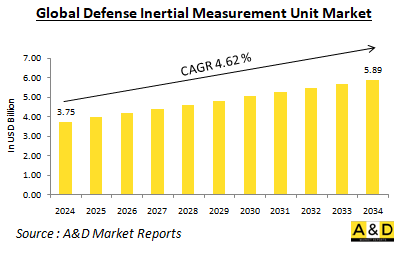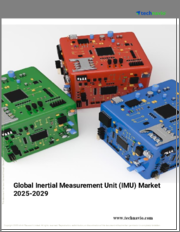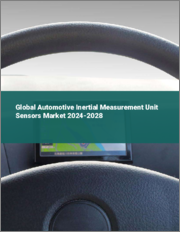
|
시장보고서
상품코드
1528158
세계의 방위용 관성 측정 장치 시장(2024-2034년)Global Defense Inertial Measurement Unit Market 2024-2034 |
||||||
세계의 방위용 관성 측정장치 시장은 2024년에 37억 5,000만 달러로 추정되며, 예측 기간 중(2024-2034년) 4.62%의 연평균 복합 성장률(CAGR)로 성장해 2034년까지 58억 9,000만 달러로 확대될 것으로 예상됩니다.

방위용 관성 측정 장치 시장 개요
관성 측정 장치(IMU)는 방위 기술에서 중요한 구성 요소이며 플랫폼의 속도, 방위 및 중력을 정확하게 측정합니다. 이러한 측정은 미사일, 항공기, 잠수함, 무인 차량 등 군사 용도의 네비게이션과 제어에 필수적입니다. IMU는 가속도계, 자이로스코프 및 경우에 따라 지자기계의 데이터를 통합하여 위치, 자세 및 속도를 계산합니다. 방어 시스템에서 IMU는 GPS 및 기타 외부 네비게이션 시스템을 사용할 수 없거나 신뢰할 수 없는 복잡한 환경에서 무기와 차량이 정확하고 효과적으로 작동할 수 있도록 합니다. 방어 시스템에 대한 IMU의 개발과 통합은 해마다 점점 더 정교 해지고 있습니다. 최신의 방위용 IMU는 가혹한 조건 하에서도 동작할 수 있는 동시에, 고정밀도, 고신뢰성, 고견뢰성을 제공하는 것이 요구되고 있습니다. 그 결과, IMU는 정확성과 탄력성이 가장 중요한 군사 작전의 효과와 안전성을 보장하는데 매우 중요한 역할을 합니다.
방위용 관성 측정 장치 시장에서의 기술의 영향력:
관성 측정 장치(IMU)를 지원하는 기술은 미세 전기 기계 시스템(MEMS), 광섬유 자이로 스코프(FOG), 링 레이저 자이로 스코프(RLG)의 발전으로 크게 진화했습니다. 이러한 진보로 IMU는 소형화, 고정밀화, 비용 절감이 가능하여 다양한 방어 플랫폼에서의 이용이 넓어지고 있습니다. MEMS 기술은 센서의 소형화를 가능하게 함으로써 IMU에 혁명을 가져와 보다 가볍고 컴팩트한 유닛을 실현했습니다. 무게와 크기가 중요한 고려사항인 무인 항공기(UAV) 및 휴대용 장치에 특히 유용합니다. MEMS 기반의 IMU는 충격과 진동에도 강하며 가혹한 군사 환경에도 적합합니다. FOG 기술은 높은 정밀도와 신뢰성을 제공하므로 미사일 유도나 함정 항행 등 엄격한 정밀도가 요구되는 용도에 최적입니다. FOG IMU는 낮은 드리프트율로 우수한 성능을 발휘하며 전투 시나리오에서 매우 중요한 전자기 간섭을 받지 않습니다. RLG는 높은 정밀도와 장기적인 안정성으로 인해 방위용 IMU의 정평이 되고 있습니다. 정확한 네비게이션과 조준 설정이 필수적인 항공기 및 미사일 시스템에서 일반적으로 사용됩니다. RLG는 가혹한 환경 조건에도 견딜 수 있는 견고한 솔루션을 제공합니다. 또한 고급 알고리즘과 센서 퓨전 기술의 통합으로 IMU의 성능이 향상되었습니다. 이 알고리즘은 여러 센서의 데이터를 결합하여 정확도를 높이고 오류를 줄여 GPS를 사용할 수 없는 환경에서도 안정적인 탐색 및 제어를 제공합니다. 이 능력은 스텔스 성과 정확성에 의존하는 방어 활동에 필수적입니다.
방위용 관성 측정 장치 시장의 주요 촉진요인:
방어 분야에서 IMU의 채택과 진보를 뒷받침하는 몇 가지 요인이 있습니다. 주요 촉진요인 중 하나는 정확성과 신뢰성에 대한 요구 증가입니다. 군사 작전이 복잡해지고 기술 주도형이 됨에 따라 정밀하고 신뢰할 수 있는 네비게이션 시스템에 대한 요구가 커지고 있습니다. IMU는 조준, 감시, 정찰 임무에 필요한 정밀도를 제공하여 방어 시스템이 동적 환경에서 효과적으로 작동할 수 있도록 합니다. 기술의 발전도 중요한 역할을 합니다. 센서 기술, 신호 처리 및 소형화의 지속적인 개선으로 IMU의 성능이 향상되고 비용이 절감됩니다. 이러한 진보로 IMU는 대형 군사 플랫폼에서 휴대용 시스템에 이르기까지 광범위한 방어 용도로 사용하기 쉬워졌습니다. IMU의 또 다른 중요한 이점은 GPS 신호와 독립적으로 작동하는 능력입니다. 도시 지역의 협곡과 수중 등 GPS를 사용할 수 없거나 신뢰할 수 없는 시나리오에서는 IMU가 내비게이션 및 제어에 필요한 데이터를 제공합니다. 이 능력은 스텔스 작전이나 전자전이 만연하고 있는 지역에서는 특히 중요합니다. 방위용도에 있어서의 자동 운전차나 드론의 대두에 의해 신뢰성이 높은 IMU 수요가 높아지고 있습니다. 이러한 시스템은 인간의 개입 없이 임무를 수행하기 위해 정확한 네비게이션과 제어에 의존하고 있으며, 그 성공에는 강력한 IMU가 필수적입니다. 마지막으로 많은 국가들이 군사 근대화 프로그램에 투자하고 있으며, 여기에는 네비게이션 및 유도 시스템 업그레이드도 포함됩니다. IMU는 이러한 업그레이드의 핵심 구성 요소이며 성능 향상을 제공하고 고급 무기 및 차량 배포를 가능하게합니다.
방위용 관성 측정 장치 시장의 지역 동향 :
세계의 방위용 IMU 시장은 지정학적 요인과 방어전략에 의해 형성되는 지역의 동향과 우선사항의 영향을 받고 있습니다. 각 지역에는 IMU의 전반적인 수요에 기여하는 독특한 촉진요인과 중점 사항이 있습니다.북미에서는 미국이 방위 예산의 많음과 기술 혁신에 주력함으로써 방위용 IMU 시장의 주요 기업이 되고 있습니다. 미군은 기술적 우위를 유지하기 위해 연구개발에 많은 투자를 하고 있으며, 이것이 IMU 기술의 진보로 이어지고 있습니다. 이 지역에서는 자율 시스템과 정밀 유도탄에 중점을 두고 있기 때문에 고성능 IMU에 대한 수요가 더욱 높아지고 있습니다. 유럽 국가들은 또한 회원국 간의 공동 프로젝트와 상호 운용성에 중점을 두고 방어 능력의 현대화에 투자하고 있습니다. 유럽 방위용 IMU 시장은 첨단 기술 개발을 지원하는 유럽 방어 기금(European Defence Fund)과 같은 이니셔티브의 혜택을 받고 있습니다. 유럽 국가들은 국내 및 국제 임무 모두에서 정확성과 신뢰성을 제공하는 IMU를 선호하며 다양한 방위용도의 높은 기준을 충족하도록 노력하고 있습니다. 아시아태평양은 지정 긴장 증가와 군사 근대화의 노력으로 방위비의 급속한 성장을 경험하고 있습니다. 중국과 인도와 같은 국가들은 자국의 자립성과 능력을 높이기 위해 IMU를 포함한 고유 방어 기술에 투자하고 있습니다. 이 지역에서는 첨단 미사일 시스템, UAV 및 해군 플랫폼 개발에 중점을 두고 있기 때문에 이러한 전략적 목표를 달성할 수 있는 고품질 IMU에 대한 수요가 증가하고 있습니다. 중동 및 아프리카에서 방어 IMU 시장은 안보 과제와 고급 방어 시스템의 필요성에 의해 견인되고 있습니다. 이 지역의 국가들은 군사력 근대화에 점점 더 투자하고 있으며, 신뢰할 수 있는 네비게이션과 유도 시스템에 대한 수요가 증가하고 있습니다. IMU는 정확한 네비게이션과 통제가 필수적인 엄격한 환경 하에서 군사 작전의 효과를 보장하는데 매우 중요한 역할을 하고 있습니다. 라틴아메리카의 국방 예산은 다른 지역에 비해 일반적으로 적지 만, 여전히 군사 능력 업그레이드에 중점을 둡니다. IMU는 전략의 정확성과 효율성을 높이기 위해 방어 시스템에 내장되어 있습니다.지역 분쟁과 국경 경비의 필요성은 네비게이션 및 유도 시스템을 포함한 방어 기술에 대한 투자를 촉진하고, IMU를 이 지역의 방어 전략의 중요한 구성 요소로 만듭니다.
방위용 관성 측정 장치의 주요 프로그램
Collins Aerospace는 영국 정부의 WSRF(Weapons Sector Research Framework)에 기여하기 위해 수백만 파운드의 계약을 획득했습니다. 이 틀은 영국 국방부의 Dstl(Defence Science and Technology Laboratory)이 감독하고 무기 과학 기술에 특화된 연구를 통해 미래의 무기 기술 개발을 가속화하는 것을 목적으로 하고 있습니다. 이 새로운 다년간 계약 하에 Collins Aerospace는 Dstl과 협력하여 새로운 복잡한 무기 플랫폼을 지원하는 관성 측정 장치(IMU)를 개발합니다. 이 전술 등급 또는 클래스 A 관성 센서는 마이크로 전기 기계 시스템(MEMS) 기술을 사용하여 개발됩니다.
목차
방위용 관성 측정 장치 시장 : 분석 정의
방위용 관성 측정 장치 시장 내역
- 플랫폼별
- 지역별
- 최종 사용자별
방위용 관성 측정 장치 시장 전망(향후 10년간)
방위용 관성 측정 장치 시장 시장 기술
세계 방위용 관성 측정장치 시장 예측
방위용 관성 측정 장치 시장 :지역별 동향과 예측
- 북미
- 촉진·억제요인, 과제
- PEST 분석
- 시장 예측과 시나리오 분석
- 주요 기업
- 공급자 계층의 상황
- 기업 벤치마킹
- 유럽
- 중동
- 아시아태평양
- 남미
방위용 관성 측정 장치 시장 : 국가별 분석
- 미국
- 방위 계획
- 최신 동향
- 특허
- 이 시장의 현재 기술 성숙 수준
- 시장 예측과 시나리오 분석
- 캐나다
- 이탈리아
- 프랑스
- 독일
- 네덜란드
- 벨기에
- 스페인
- 스웨덴
- 그리스
- 호주
- 남아프리카
- 인도
- 중국
- 러시아
- 한국
- 일본
- 말레이시아
- 싱가포르
- 브라질
시장 기회 매트릭스
조사에 관한 전문가의 견해
결론
Aviation and Defense Market Reports 정보
JHS 24.08.14The Global Defense Inertial Measurement Unit market is estimated at USD 3.75 billion in 2024, projected to grow to USD 5.89 billion by 2034 at a Compound Annual Growth Rate (CAGR) of 4.62% over the forecast period 2024-2034.

Introduction to Defense Inertial Measurement Units Market:
Inertial Measurement Units (IMUs) are critical components in defense technology, providing precise measurements of a platform's velocity, orientation, and gravitational forces. These measurements are essential for navigation and control in military applications such as missiles, aircraft, submarines, and unmanned vehicles. IMUs work by integrating data from accelerometers, gyroscopes, and sometimes magnetometers to calculate position, orientation, and velocity. In defense systems, IMUs ensure that weapons and vehicles can operate accurately and effectively in complex environments where GPS or other external navigation systems may be unavailable or unreliable. The development and integration of IMUs into defense systems have become increasingly sophisticated over the years. Modern defense IMUs are required to provide high accuracy, reliability, and robustness while being capable of operating in extreme conditions. As a result, they play a pivotal role in ensuring the effectiveness and safety of military operations, where precision and resilience are paramount.
Technology Impact in Defense Inertial Measurement Units Market:
The technology underpinning Inertial Measurement Units (IMUs) has evolved significantly, driven by advances in micro-electromechanical systems (MEMS), fiber optic gyroscopes (FOG), and ring laser gyroscopes (RLG). These advancements have allowed IMUs to become smaller, more precise, and more cost-effective, expanding their applications across various defense platforms. MEMS technology has revolutionized IMUs by enabling the miniaturization of sensors, leading to lighter and more compact units. This has been particularly beneficial for unmanned aerial vehicles (UAVs) and portable devices, where weight and size are critical considerations. MEMS-based IMUs are also more resilient to shock and vibration, making them suitable for harsh military environments. FOG technology offers high precision and reliability, making it ideal for applications requiring stringent accuracy, such as missile guidance and naval navigation. FOG IMUs provide excellent performance with low drift rates and are immune to electromagnetic interference, which is crucial in combat scenarios. RLGs have been a staple in defense IMUs due to their high accuracy and stability over time. They are commonly used in aircraft and missile systems where precise navigation and targeting are essential. RLGs offer a robust solution that can withstand extreme environmental conditions. Additionally, the integration of advanced algorithms and sensor fusion techniques has enhanced the performance of IMUs. These algorithms combine data from multiple sensors to improve accuracy and reduce errors, ensuring reliable navigation and control even in GPS-denied environments. This capability is vital for defense operations that rely on stealth and precision.
Key Drivers in Defense Inertial Measurement Units Market:
Several factors drive the adoption and advancement of IMUs in the defense sector. One major driver is the increasing demand for precision and reliability. As military operations become more complex and technology-driven, there is a growing need for precise and reliable navigation systems. IMUs provide the accuracy required for targeting, surveillance, and reconnaissance missions, ensuring that defense systems operate effectively in dynamic environments. Technological advancements also play a crucial role. Continuous improvements in sensor technology, signal processing, and miniaturization are enhancing the performance and reducing the cost of IMUs. These advancements make IMUs more accessible for a wider range of defense applications, from large military platforms to portable systems. Another critical advantage of IMUs is their ability to operate independently of GPS signals. In scenarios where GPS is unavailable or unreliable, such as in urban canyons or underwater, IMUs provide the necessary data for navigation and control. This capability is particularly important for stealth operations and in areas where electronic warfare is prevalent. The rise of autonomous vehicles and drones in defense applications has increased the demand for reliable IMUs. These systems rely on accurate navigation and control to perform missions without human intervention, making robust IMUs essential for their success. Finally, many countries are investing in military modernization programs, which include upgrading navigation and guidance systems. IMUs are a key component of these upgrades, providing enhanced performance and enabling the deployment of advanced weaponry and vehicles.
Regional Trends in Defense Inertial Measurement Units Market:
The global defense IMU market is influenced by regional trends and priorities, shaped by geopolitical factors and defense strategies. Each region has unique drivers and focuses that contribute to the overall demand for IMUs. In North America, the United States is a major player in the defense IMU market, driven by its significant defense budget and focus on technological innovation. The U.S. military invests heavily in research and development to maintain its technological edge, leading to advancements in IMU technology. The region's emphasis on autonomous systems and precision-guided munitions further fuels the demand for high-performance IMUs. European countries are also investing in modernizing their defense capabilities, with a focus on collaborative projects and interoperability among member states. The European defense IMU market benefits from initiatives like the European Defence Fund, which supports the development of advanced technologies. European nations prioritize IMUs that offer precision and reliability for both domestic and international missions, ensuring they meet high standards for various defense applications. The Asia-Pacific region is experiencing rapid growth in defense spending, driven by rising geopolitical tensions and military modernization efforts. Countries such as China and India are investing in indigenous defense technologies, including IMUs, to enhance their self-reliance and capabilities. The region's focus on developing advanced missile systems, UAVs, and naval platforms boosts the demand for high-quality IMUs that can meet these strategic objectives. In the Middle East and Africa, the defense IMU market is driven by security challenges and the need for advanced defense systems. Countries in this region are increasingly investing in modernizing their military forces, leading to a growing demand for reliable navigation and guidance systems. IMUs play a crucial role in ensuring the effectiveness of military operations in challenging environments, where precise navigation and control are essential. While the defense budgets in Latin America are generally smaller compared to other regions, there is still a focus on upgrading military capabilities. IMUs are integrated into defense systems to enhance the precision and effectiveness of operations. Regional conflicts and the need for border security drive investments in defense technology, including navigation and guidance systems, making IMUs a vital component of defense strategies in the region.
Key Defense Inertial Measurement Unit Program:
Collins Aerospace has secured a multimillion-pound contract to contribute to the British Government's Weapons Sector Research Framework (WSRF). This framework is overseen by the UK Ministry of Defence's Defence Science and Technology Laboratory (Dstl) and aims to accelerate the development of future weapons technologies through dedicated research in weapons science and technology. Under this new multi-year contract, Collins Aerospace will collaborate with Dstl to create an Inertial Measurement Unit (IMU) to support emerging complex weapons platforms. This tactical grade or Class A inertial sensor will be developed using micro-electro-mechanical systems (MEMS) technology.
Table of Contents
Market Definition
Market Segmentation
By Platform
By Region
By End - User
10 Year Market Outlook
The 10-year market outlook would give a detailed overview of changing dynamics, technology adoption overviews and the overall market attractiveness is covered in this chapter.
Market Technologies
This segment covers the top 10 technologies that is expected to impact this market and the possible implications these technologies would have on the overall market.
Global Market Forecast
The 10-year market forecast of this market is covered in detailed across the segments which are mentioned above.
Regional Market Trends & Forecast
The regional market trends, drivers, restraints and Challenges of this market, the Political, Economic, Social and Technology aspects are covered in this segment. The market forecast and scenario analysis across regions are also covered in detailed in this segment. The last part of the regional analysis includes profiling of the key companies, supplier landscape and company benchmarking.
North America
Drivers, Restraints and Challenges
PEST
Market Forecast & Scenario Analysis
Key Companies
Supplier Tier Landscape
Company Benchmarking
Europe
Middle East
APAC
South America
Country Analysis
This chapter deals with the key defense programs in this market, it also covers the latest news and patents which have been filed in this market. Country level 10 year market forecast and scenario analysis are also covered in this chapter.
US
Defense Programs
Latest News
Patents
Current levels of technology maturation in this market
Market Forecast & Scenario Analysis
Canada
Italy
France
Germany
Netherlands
Belgium
Spain
Sweden
Greece
Australia
South Africa
India
China
Russia
South Korea
Japan
Malaysia
Singapore
Brazil
Opportunity Matrix
The opportunity matrix helps the readers understand the high opportunity segments in this market.
Expert Opinions
Hear from our experts their opinion of the possible outlook for this market.
Conclusions
About Aviation and Defense Market Reports


















